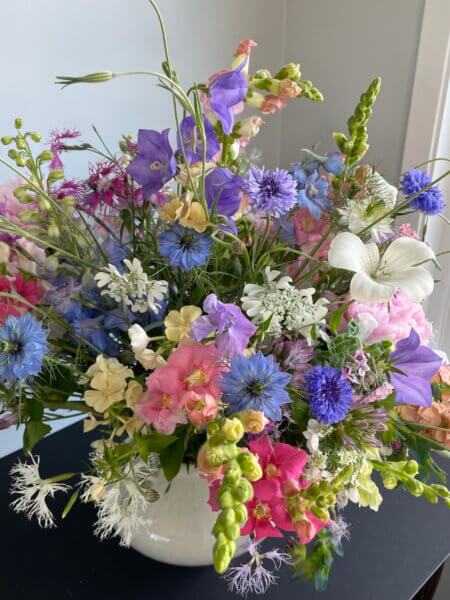Autumn planting: ranunculus and anemones
I dropped into the local GardenWorks the other day looking for cell seed trays. The place was full of pumpkins and Christmas decorations, but not a seed tray in sight. Now I love Christmas, and my heart admittedly beats a little faster when confronted by a bauble, but this is a garden centre, right, and no seed trays? When asked, the fellow at the counter admitted that it was about time they realised people were starting to sow in autumn nowadays, but all he could offer me was a cell seed tray included in a full propagation kit complete with heating mat. Great Christmas present for a young gardener perhaps, but a bit excessive for starting off a few larkspur.
The weather has finally changed here in Victoria, but it’s not quite time to lay down the trowel yet, and, as in most temperate climates, the main task for this month – October – is planting bulbs and tubers.

It’s my first autumn in this garden and I want to take my time deciding on permanent bulbs like narcissi, so I’ve planted only two varieties that I really must have for the sake of the fragrance – N. ‘Actaea’ (left), the poet’s daffodil and N. ‘Geranium’ – and a mix of fragrant ruffled double narcissi from Five Acres Flower Farm.
With tulips, however, I’ve gone a bit overboard. These deer treats are in the back, behind an eight-foot fence, some in the ground, but the majority in pots, lasagne style, to experiment with different combinations. In the hope of deterring the squirrels, I’m sprinkling cloves on the earth and in the pots. So far, so good. There has been one attempt to scratch up my favourite ‘Apricot Parrot’ which appears to have been quickly abandoned. Clearly not everyone is into pumpkin spice. We’ll see how it goes when the squirrels get hungrier.

What’s really making me happy, though, is that my greenhouse is up and running and that means I can experiment with starting some anemones and ranunculus now. I’m not heating the greenhouse, just keeping it frost free, and that’s ideal for starting off these cool season flowers. Of course you can plant them in the spring, but for the best flowers, the earliest, and the longest period of bloom, in zones 7 and up, this is the time to do it.

Theoretically, here in Victoria they could be planted directly in the garden in the autumn, and just protected if a hard frost is predicted. But my experience in Scotland with winter rains makes me wary. Anemones and ranunculus are surprisingly tough plants, belying their delicate appearance. They don’t mind the cold and can even take a touch of frost, but excess damp equals death: they are so prone to rotting. If you don’t have a greenhouse, a cold frame or mini plastic greenhouse would suffice, just throwing on some fleece as extra protection when frost is forecast.
So this is the plan, an adaptation of what I used to do in Scotland, and we’ll see how it works. I’m starting off some ranunculus and anemone tubers now, in October. In January, I’ll plant some out in the garden (with protection, I’ll be using a low level plastic tunnel), transfer others into larger pots for outside, and keep a few growing in the greenhouse to see what works best. With luck, the anemones should start to flower by March (a bit after I’ve begun my second planting) and ranunculus by April. I’ll post updates on my progress.
How to start the tubers
Here’s the process for starting tubers now, if you haven’t tried this before:
• First soak your tubers. Ranunculus need to be soaked for only 3 or 4 hours; anemones need longer, between 12-24 hours. The tubers will swell up.

• Now plant them into 9cm square pots, using potting compost mixed with perlite, or better, if you can find it, horticultural grit: this is mainly to ensure good drainage. Ranunculus are planted with the little legs downward. It’s more difficult to tell the top of an anemone but you might see a circular marking on the tuber which identifies the top (if you don’t, no matter, it will find its own way up anyway).

•Keep just moist enough to stop them going dormant again, but not wet. If it gets very cold, you can pop on a propagator lid, and perhaps some fleece to give the plants extra protection, but don’t leave it on too long: they need air. Most importantly, keep the greenhouse or cold frame well-ventilated.

• The ranunculus may start producing shoots quite fast; the anemones may take their time. They should both grow slowly and make stocky plants. Once they are up and running, you can give them a feed of weak seaweed solution.
Where to buy your tubers
Most large bulb companies will have a small selection of bog standard anemones and ranunculus, although most focus on spring sales for these tubers. But if you want to grow some really gorgeous flowers then you need to look elsewhere.
UK and Europe: Farmer Gracy: Based in the Netherlands and the UK, this was always my favourite bulb company when I lived in Europe. They stock unusual bulbs of all kinds and have an excellent selection of Italian anemones and ranunculus. Prices are also very good. For example, you can get 10 Mistral ‘Blanco centro Nero’ anemone tubers for under 5£ (less than 6USD and 8CAD) and 10 Elegance ‘Bianco Sfumato’ ranunculus for under 8£ (about 9USD and 12CAD). You won’t find prices like this outside Europe where most specialities have been developed: North American growers and sellers have to deal with customs and import taxes.
USA: There’s a wealth of opportunity for those wanting something different in the USA. The selection of ranunculus at Eden Brothers is eye opening, for example, but you just can’t beat the over 70 varieties offered at Fleur Farm where you can get Butterfly, Romance and Clonal ranunculus. I am lusting after the clonal ‘Chartreuse’, 5 tubers for 27.95USD, and ‘Ginette‘, 5 tubers for 34.95USD, and absolutely any of the Romance series, but unfortunately Fleur Farm had to give up sending to Canada because of rising costs and other complications.
Canada: Unsurprisingly, Canada is the most difficult place to obtain unusual bulbs. The few big bulb companies offer next to nothing in the way of exciting ranunculus and anemones and for these you must look to the specialist flower farmers. For the interest of Canadian readers, I am putting together a short post on some of these specialists will post within a day or two. These are smaller, often family businesses, and they offer exceptional service and exceptional quality. Update: I have to wait for permission for images, so I hope to have this post up on early next week. In the meantime, if you want to buy tubers, you could check the selections at Antonio Valente Flowers and at Dahlia May Flower Farm.
Receive updates via email of new articles.
Receive updates via email of new articles.
Latest Articles

Crazy about Cosmos

Flowers for summer bouquets I

Ranunculus Revisited

Review of Rachel Siegfried’s The Cut Flower Sourcebook

Tulips

Victorian flower arranging

Easter lilies

Spring has sprung: here comes the daffodil

Pleasures of the nose: fragrant flowers in early spring

Violets for Valentine
Subscribe to My Blog
Enter your email address to receive an email notification whenever a new article is posted.
